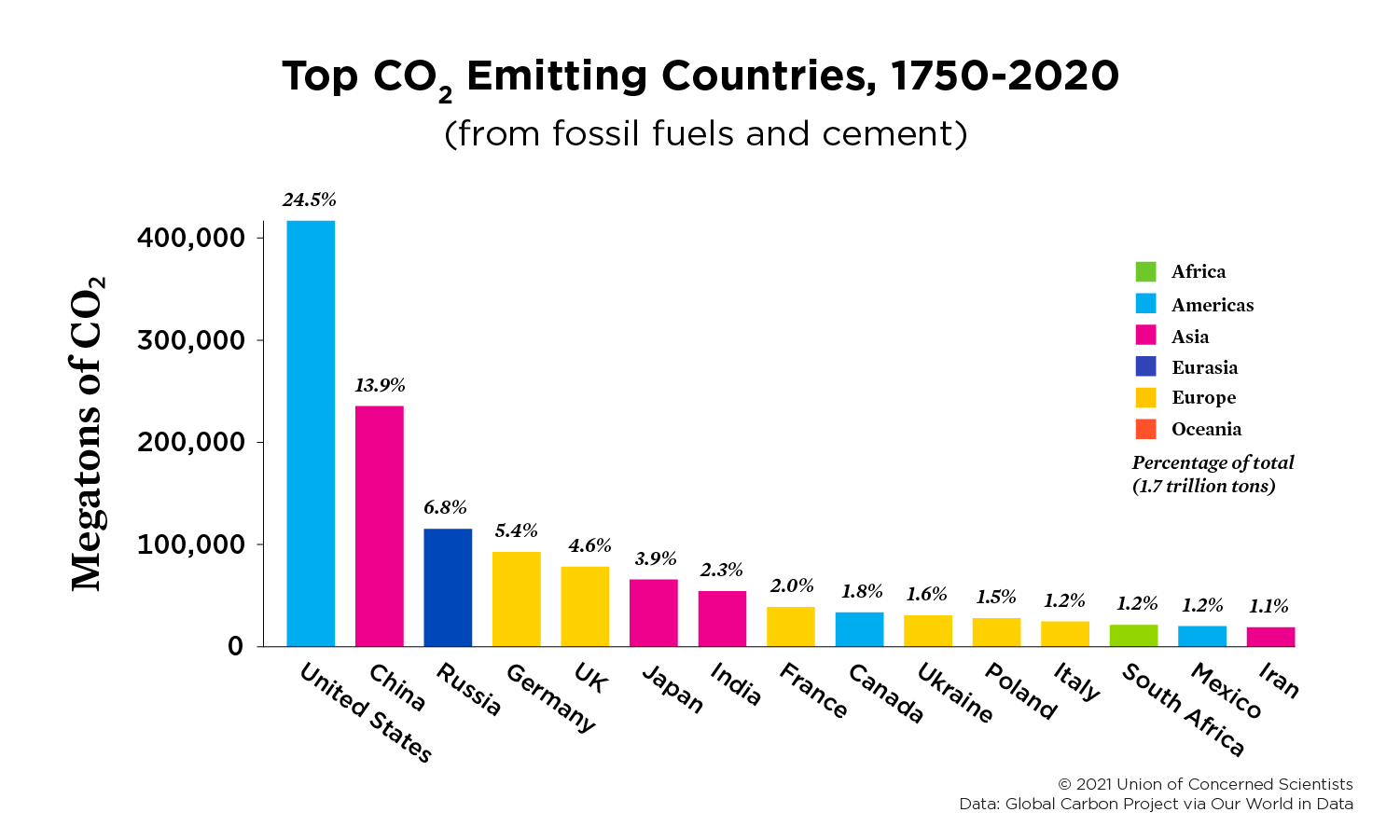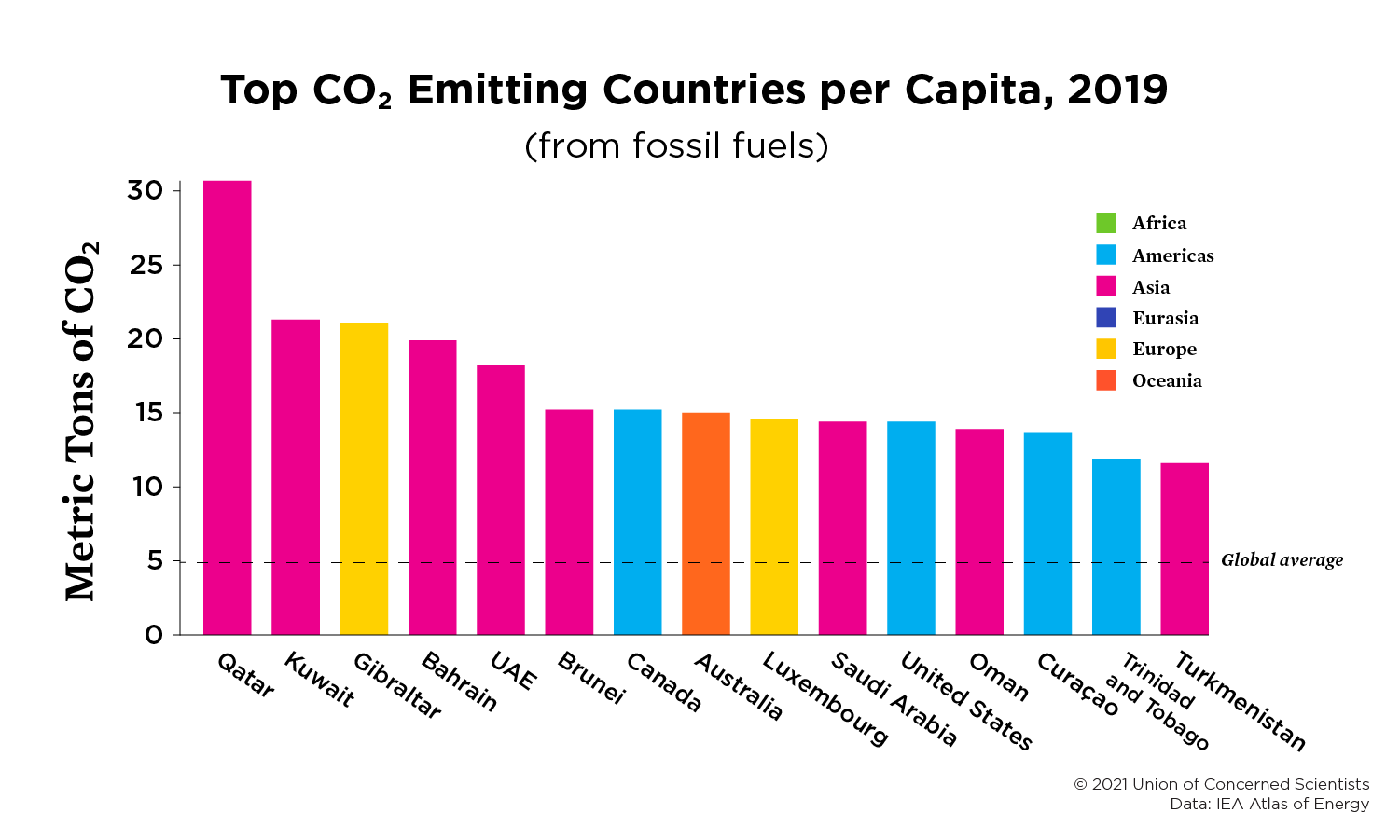We’re sometimes asked “Isn’t population growth driving climate change?” But that’s the wrong question—and it can lead to dangerous answers.
We frequently receive questions about population growth and its relationship to climate change. It’s an old idea with a troubling history. In the context of solving the climate crisis, it's distracting at best, and at worst, has the potential to do great harm to the climate and to people around the world.
Here are the facts: climate change is caused by the heat-trapping emissions produced when we burn coal, oil, and gas, and cut down forests. Data show that these emissions are most closely connected to carbon-intensive production and consumption patterns, predominantly the carbon-intensive lifestyles of the relatively wealthy, both here in the United States and around the world. Fossil fuel companies, utilities, and their trade groups also bear significant responsibility: they have used their power, money and deceptive tactics to lock in carbon-intensive infrastructure and constrain choices individuals can make about their energy supply.
A misplaced focus on population growth as a key driver of past, present, and future climate change conflates a rise in emissions with an increase in people, rather than the real source of those emissions: an increase in cars, power plants, airplanes, industries, buildings, and other parts of our fossil fuel-dependent economy and lifestyles. Implicit in this faulty framing is the notion that all people contribute significantly to heat-trapping emissions. In fact, data show (PDF) that the richest 10 percent of the world’s population contributes 50 percent of annual global warming emissions.
A supremely unjust reality is that the impacts of climate change are falling disproportionately on the very populations that have contributed the least to the problem in the first place.
This deeply flawed frame also takes the focus off urgently needed, effective, real climate solutions, including switching to low-carbon forms of energy, ramping up energy efficiency, and enhancing the health of our forests and soils that nurture life and help store carbon.
The correlation between the rise in global heat-trapping emissions and global population has also been misinterpreted and misused to advance discriminatory, racist, and xenophobic arguments for population control and against immigration. This has been particularly harmful to Black and Brown people, marginalized communities, and people who live in poverty—and it is specifically an attack on reproductive rights and the rights of women. “Population control” has even been used by terrorists and white supremacists as motivation for violent acts, such as the 2019 terrorist attacks in El Paso, TX and Christchurch, New Zealand.
UCS’s 50-year history includes a brief period during the 1990s when we did work on population and the environment. This includes work that we now understand to be deeply problematic and enmeshed in racist frames. Notably, the famous 1992 World Scientists’ Warning to Humanity includes references to pressures from “unrestrained population growth,” and specific language targeted at developing countries (“Developing nations must realize that environmental damage is one of the gravest threats they face, and that attempts to blunt it will be overwhelmed if their populations go unchecked.”) As we face into the future, we are building on the best of our legacy while also being transparent about and accountable for aspects of past work that are no longer accurate and, in some cases, harmful.

Which countries are most responsible for climate change?
Cumulative carbon dioxide emissions are the dominant driver of climate change. These began rising during the Industrial Revolution (especially after 1850)—which means richer countries like the United States, which made an early transition to a heavily fossil fuel-based economic system, have an outsized role in contributing to the climate impacts we see around the world today.
Both in terms of cumulative emissions, and current per capita emissions, richer countries rank high. Conversely, low- and middle-income countries have lower cumulative historical emissions and per capita emissions. Even within countries, it is the relatively rich who are most responsible for a majority of carbon emissions.

How focusing on population causes harm
Efforts to link population growth and environmental degradation, and in recent years population growth and climate change, tend to wrongly assume a simple and direct relationship between human numbers and environmental impacts such as deforestation, species loss, and greenhouse gas emissions. People living near areas of environmental degradation get blamed, even if the main drivers of those problems are consumption and production choices far away—such as when forests get cleared for timber, or to grow livestock or cash crops, for export.
In this misguided frame, efforts to reduce fertility rates and limit resource consumption become paramount “solutions,” even though they are often directed at people who already have very low, even subsistence-level, consumption patterns. And they fail to address the primary drivers.
Theories of overpopulation have been offered as supposedly "natural" laws to explain resource scarcity and justify population control—a scarcity that is, in fact, often the product of a system focused almost exclusively on profits and not societal needs. An economic and governance system that focuses on broader social benefits, instead of emphasizing corporate profits and an extractive framework, would go a long way towards addressing the root causes of scarcity.
Arguments about overpopulation are also used to promote coercive population control measures and human rights abuses, including forced sterilization and family-size limitations, that primarily affect Black, Brown and Indigenous communities and people who live in poverty. Furthermore, anti-immigration advocates in the United States, Europe, and elsewhere continue to use the threat of future consumption patterns and environmental degradation to argue for stricter limits to legal immigration and refugee flows from the global South—even as some western countries provide per-child subsidies to expand their native-born populations.
Real climate solutions
Promoting population control as a solution to climate change does not address the drivers of the problem. It reinforces inaccurate views that won’t help make progress, and perpetuates often racist frames that harm people who hold the least responsibility for climate change
Instead, we must tackle climate change in a just and equitable way by making swift and deep cuts in our heat-trapping emissions, investing in climate resilience, and working together with the nations of the world to fulfil the promise of the Paris Agreement in the context of sustainable development and efforts to eradicate poverty, as called for in the agreement.
The United States must clean up our power system, and sharply reduce emissions from the transportation sector. We must increase efficiency and electrify energy use in the buildings and industrial sectors. We must cut heat-trapping emissions from the food and agricultural sector and enhance the health and carbon storage capabilities of soils and forests. Absolute, deep cuts in emissions must remain the primary means to limit global warming—but we’ll also need technologies and practices that remove carbon dioxide from the atmosphere.
And we must adopt measures that lower the overall climate footprint of our lifestyles and diets, especially for those segments of the population who have an outsized footprint. Moving towards more sustainable dietary patterns and food systems can help reduce heat-trapping emissions, while improving health and reducing pollution. Changes in how we develop and redevelop our towns and cities—including choices about land use and investments in transit and walkability—can help cut emissions while contributing to healthier communities. Finally, we must eliminate the harmful influence of fossil fuel companies on our climate and clean energy policies and hold them accountable for their actions.
Our solutions to climate change must be inclusive and just, and we must reject frames that implicitly or explicitly endorse racist or white supremacist ideologies. The world depends on it.
UCS understands and appreciates that there are many groups doing valuable work on reproductive rights and women’s rights from a justice-centered perspective. We have great respect for that work. This webpage is intentionally centered on the climate dimensions of the population issue, given the focus of our work and expertise.




